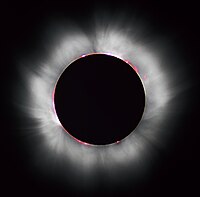
Photo from wikipedia
We compared the long-term variation (1992 – 2017) in solar polar brightening observed with the Nobeyama Radioheliograph, the polar solar-wind velocity with interplanetary scintillation observations at the Institute for Space-Earth Environmental Research,… Click to show full abstract
We compared the long-term variation (1992 – 2017) in solar polar brightening observed with the Nobeyama Radioheliograph, the polar solar-wind velocity with interplanetary scintillation observations at the Institute for Space-Earth Environmental Research, and the coronal-hole distribution computed by potential-field calculations of the solar corona using synoptic magnetogram data obtained at the National Solar Observatory/Kitt Peak. First, by comparing the solar-wind velocity [V$V$] and the brightness temperature [Tb$T_{\mathrm{b}}$] in the polar region, we found good correlation coefficients (CCs) between V$V$ and Tb$T_{\mathrm{b}}$ in the polar regions, CC = 0.91 (0.83) for the northern (southern) polar region, and we obtained the V$V$–Tb$T_{ \mathrm{b}}$ relationship as V=12.6$V = 12.6$(Tb−10,667)1/2+432$(T_{\mathrm{b}}-10{,}667)^{1/2}+432$. We also confirmed that the CC of V$V$–Tb$T_{\mathrm{b}}$ is higher than those of V$V$–B$B$ and V$V$–B/f$B/f$, where B$B$ and f$f$ are the polar magnetic-field strength and magnetic-flux expansion rate, respectively. These results indicate that Tb$T_{\mathrm{b}}$ is a more direct parameter than B$B$ or B/f$B/f$ for expressing solar-wind velocity. Next, we analyzed the long-term variation of the polar brightening and its relation to the area of the polar coronal hole [A$A$]. As a result, we found that the polar brightening matches the probability distribution of the predicted coronal hole and that the CC between Tb$T_{\mathrm{b}}$ and A$A$ is remarkably high, CC = 0.97. This result indicates that the polar brightening is strongly coupled to the size of the polar coronal hole. Therefore, the reasonable correlation of V$V$ – Tb$T_{\mathrm{b}}$ is explained by V$V$ – A$A$. In addition, by considering the anti-correlation between A$A$ and f$f$ found in a previous study, we suggest that the V$V$ – Tb$T_{\mathrm{b}}$ relationship is another expression of the Wang–Sheeley relationship (V$V$ – 1/f$1/f$) in the polar regions.
Journal Title: Solar Physics
Year Published: 2019
Link to full text (if available)
Share on Social Media: Sign Up to like & get
recommendations!